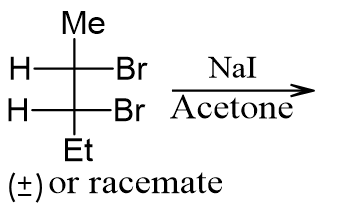Chemistry-
General
Easy
Question
Which of the following is the correct order of stability of the following compound?
I) 
II) 
III) 
- (I)>(II)>(III)
- (III)>(II)>(I)
- (II)>(I)>(III)
- (I)>(III)>(II)
The correct answer is: (I)>(II)>(III)
(I)  aromatic, (II)= non-aromatic
aromatic, (II)= non-aromatic  but not in delocalisation)
but not in delocalisation)
(III)  anti-aromatic (
anti-aromatic ( but in delocalisation). So the order of stability is: (I)>(II)>(III)
but in delocalisation). So the order of stability is: (I)>(II)>(III)
Related Questions to study
Chemistry-
Which of the following reactions would give  -alkene?
-alkene?
I) 
II) 
III) 
IV) 
Which of the following reactions would give  -alkene?
-alkene?
I) 
II) 
III) 
IV) 
Chemistry-General
Chemistry-
 (A) (B)& (C) are:
(A) (B)& (C) are:
 (A) (B)& (C) are:
(A) (B)& (C) are:
Chemistry-General
Maths-
If the sides of a triangle ABC are a, b and c such that 2b = a + c, then exhaustive range of
then exhaustive range of  is
is
If the sides of a triangle ABC are a, b and c such that 2b = a + c, then exhaustive range of
then exhaustive range of  is
is
Maths-General
Chemistry-
 A, B, and C are:
A, B, and C are:
I) 
II) 
III) 
 A, B, and C are:
A, B, and C are:
I) 
II) 
III) 
Chemistry-General
Chemistry-
The decreasing order of nucleophilicities in  (dimethylsulphoxide) is:
(dimethylsulphoxide) is:
The decreasing order of nucleophilicities in  (dimethylsulphoxide) is:
(dimethylsulphoxide) is:
Chemistry-General
Chemistry-
In which of the following reactions,  rate increases on changing the solvent from (95% acetone
rate increases on changing the solvent from (95% acetone  ) to (80% acetone + 20%
) to (80% acetone + 20%  )?
)?
In which of the following reactions,  rate increases on changing the solvent from (95% acetone
rate increases on changing the solvent from (95% acetone  ) to (80% acetone + 20%
) to (80% acetone + 20%  )?
)?
Chemistry-General
Chemistry-
Consider the following reaction:

Find out which of the following statements is wrong?
Consider the following reaction:

Find out which of the following statements is wrong?
Chemistry-General
Chemistry-
Which of the following compounds would undergo Diels-Alder reaction?
I) 
II) 
III) 
IV) 
Which of the following compounds would undergo Diels-Alder reaction?
I) 
II) 
III) 
IV) 
Chemistry-General
Chemistry-
Arrange the following in the decreasing order of nucleophilic acyl substitution reaction?
I) 
II) 
III) 
IV) 
Arrange the following in the decreasing order of nucleophilic acyl substitution reaction?
I) 
II) 
III) 
IV) 
Chemistry-General
Chemistry-
Consider the following reaction:

The product is:
Consider the following reaction:

The product is:
Chemistry-General
Chemistry-
 Which statement is correct about the above reaction?
Which statement is correct about the above reaction?
 Which statement is correct about the above reaction?
Which statement is correct about the above reaction?
Chemistry-General
Chemistry-
There are two paths to prepare a compound (A) (2-methyl-hex-1-en-3-yne). Which of the following statements is correct?

There are two paths to prepare a compound (A) (2-methyl-hex-1-en-3-yne). Which of the following statements is correct?

Chemistry-General
Chemistry-
 Compound (C) is:
Compound (C) is:
 Compound (C) is:
Compound (C) is:
Chemistry-General
Chemistry-
Chemistry-General
Chemistry-
Rearrangement reactions are shown by:
Rearrangement reactions are shown by:
Chemistry-General





